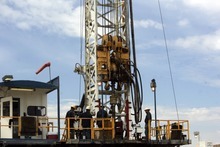This is an archived article that was published on sltrib.com in 2012, and information in the article may be outdated. It is provided only for personal research purposes and may not be reprinted.
Utah manufacturing activity in August climbed to the highest level in five months on strong production from the state's oil wells and sales by companies tied to the energy industry.
The Goss Institute for Economic Research on Monday said its index of business conditions in the state rose to an unexpected 60.6 from July's reading of 55. A reading above 57 indicates robust activity.
"The survey results were a lot stronger than I anticipated, stronger than the national numbers. It's energy and energy-related, but also manufacturing. It's pretty positive," Goss said, adding that September's reading will probably be lower. Political and economic uncertainty are stalling growth, he said.
"I don't see how it can continue, with the U.S. economy really pulling back. It could continue if you got a strong uptick in housing, but I don't see that happening."
Nationally, factory activity shrank for the third straight month in August as new orders, production and employment all fell.
The Institute for Supply Management, a trade group of purchasing managers, said Tuesday its national index of manufacturing activity ticked down to 49.6. That's down from 49.8 in July and the lowest reading in three years. A reading below 50 indicates contraction. The report adds to other signs that manufacturing generally is struggling around the globe.
Weak consumer spending and steady declines in business orders for large machinery and other capital goods are slowing factory output.
The report followed other data showing manufacturing has slowed overseas. A measure of factory activity in China fell to its lowest level in more than three years last month. And manufacturing in Europe has also stagnated in the face of the region's financial crisis.
Paul Dales, senior U.S. economist at Capital Economics, said continued uncertainty caused by the recession in Europe, the slowdown in Asia and impending tax increases and spending cuts in the United States "is taking its toll on activity."
"The manufacturing index typically needs to fall to about 43 to suggest the broader economy is shrinking, according to the ISM. Still, growth at or below 2 percent is not enough to significantly lower the unemployment rate, which was 8.3 percent in July.
And the slight decline in manufacturing activity also makes it more likely the Federal Reserve will take steps at its meeting next week to boost economic growth, Dales said.
The stock market fell after the ISM data and a separate report on construction spending were released. Construction spending fell sharply in July. The Dow Jones industrial average dropped 96 points in early trading before settling down 55 points.
U.S. factories have been a key source of jobs and growth since the recession ended in June 2009. But the sector has shown signs of weakness in recent months.
The ISM survey showed factories kept hiring in July but at a slower pace. And production dropped sharply to 47.2, the first time it has fallen below 50 since May 2009, when the economy was in recession.
New orders, a sign of future production, also dropped. New export orders increased but remained below 50, contracting for the third straight month.
Recent data suggest the economy picked up a little in July, which could boost factory production in the second half of the year. Employers added 163,000 jobs, the best hiring since February. And consumers stepped up spending last month after earning a little more.
The government will report on August hiring and unemployment on Friday.



